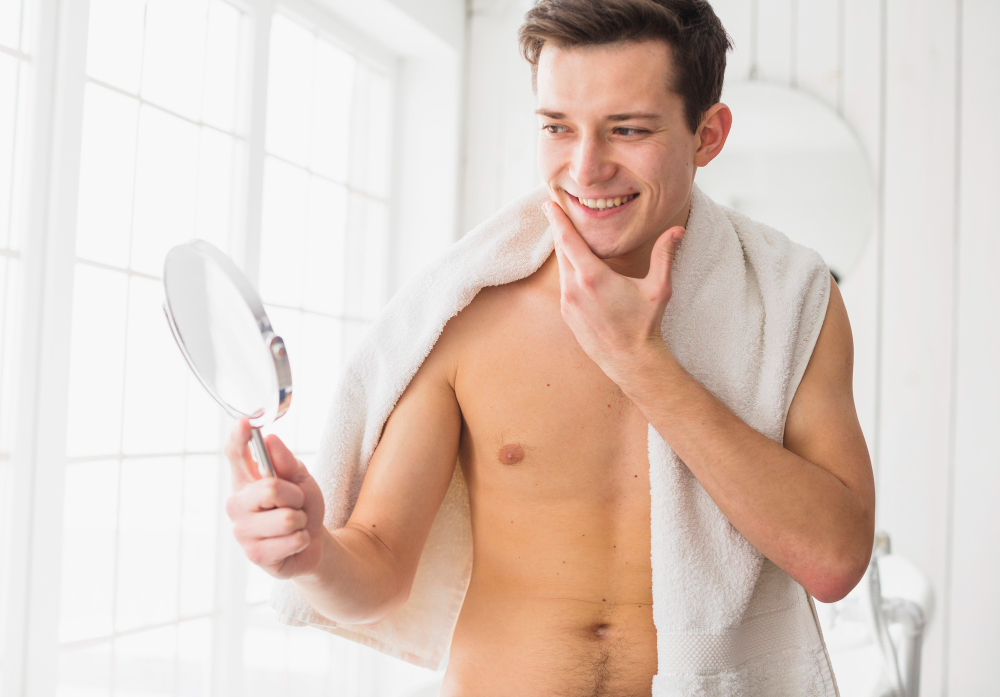Shaving Bumps: Causes, Treatment, and Prevention

This guide is for anyone who experiences irritation or bumps after shaving, regardless of skin type. Dealing with shaving bumps can be frustrating and painful. You’re in the right place to find relief. Shaving bumps can cause discomfort, affect appearance, and lead to more serious skin issues if not managed properly. This article will explain what shaving bumps are, why they happen, and provide practical steps to prevent and treat them.
Key Takeaways
- Proper shaving techniques, such as exfoliating regularly and using moisturizing shaving cream, can help prevent the formation of shaving bumps.
- Effective treatments for existing shaving bumps include using aloe vera, salicylic acid, and warm compresses to soothe irritation and promote healing.
- For those frequently experiencing shaving bumps, alternative hair removal methods like IPL (Intense Pulsed Light) can offer a longer-term solution.
Quick Links
Understanding Shaving Bumps
Razor bumps are ingrown hairs that develop after shaving or using other hair removal techniques. The medical term for razor bumps is pseudofolliculitis barbae. Ingrown hairs, also known as razor bumps or pseudofolliculitis barbae, can develop when you shave or use other hair removal methods. They are a common occurrence and can cause irritation and discomfort.
These bumps occur when hair is cut too short and curls back into the skin, leading to inflammation and irritation within the hair follicles. In particular, beard hairs can emerge from the skin at lower angles, making them more prone to becoming ingrown.
Ingrown hairs occur when hair curls back into the hair follicle, causing further irritation. The shape of the hair shaft can also contribute to the likelihood of bumps, as irregular or dry hair shafts are more likely to pierce back into the skin.
This condition is more prevalent in individuals with coarse, curly hair, as these hair types and especially curly hairs tend to curve back into the skin after being cut. Research suggests that males of African descent are more susceptible to razor bumps than other people. When hair curls back into the skin, it can cause irritation and inflammation.
Razor bumps can develop anywhere a person shaves or removes hair, including the face, head, legs, armpits, and pubic area. These pesky bumps can appear anywhere you shave or remove hair, including the face, legs, armpits, and pubic area.
The beard area is a common site for shaving bumps, especially in men. Razor bumps are visible on the skin’s surface as raised, inflamed bumps. Although both razor bumps and ingrown hairs are raised bumps resulting from hair removal, their nature is different.
Razor bumps are caused by hair curling back into the skin, whereas ingrown hairs occur when hair grows sideways into the skin.
Causes of Shaving Bumps
Shaving bumps are primarily caused by improper shaving techniques and various hair removal methods. Some common causes include:
- Shaving too closely
- Using a dull blade
- Pressing too hard while shaving
- Shaving against the grain
- Not using enough lubrication
- Shaving too quickly
These factors can cause hair to re-enter the skin, leading to irritation and bumps. As hairs grow back, they can sometimes re-enter the skin, which leads to bumps and inflammation. Additionally, individuals with naturally curly or coarse hair are more likely to develop razor bumps, as these hair types tend to curl back into the skin after being cut.
Razor bumps most commonly occur in people with naturally curly or coarse hair.
Razor burns are another form of irritation caused by shaving, and they are distinct from razor bumps. Razor burns typically present as redness, tenderness, and itching after shaving. Razor burn tends to cause irritation immediately after shaving.
Sensitive skin also plays a role in the development of shaving bumps. Those with sensitive skin are more prone to irritation, increasing the likelihood of bumps. Moreover, certain genetic factors, such as skin folds or scar tissue in areas where hair is removed, can make one more susceptible to razor bumps. Comprehending these causes aids in the effective prevention and treatment.
Shaving, waxing, plucking, and chemical depilatories are all methods that remove hair and can contribute to bumps, especially if not performed properly.
Symptoms of Shaving Bumps
Physical Symptoms
The symptoms of shaving bumps are quite noticeable. They often present as raised, red, inflamed areas on the skin. These bumps can resemble tiny pimples or pustules, caused by ingrown hairs growing into the skin instead of out.
Shaving bumps frequently appear as itchy bumps, causing significant discomfort in addition to their unsightly appearance. The discomfort and unsightly appearance can be frustrating, especially when they appear in visible areas like the face or neck.
Shaving bumps, also known as razor bump, are not just a visual nuisance; they can be quite uncomfortable. Itching, pain, and general discomfort often accompany these bumps. Common symptoms include redness, pain, and sometimes even razor burn, which is a separate but related irritation caused by shaving.
Psychological Impact
Along with physical symptoms, shaving bumps can also cause psychological discomfort. The itching and irritation can be particularly bothersome, especially if the area is not properly moisturized after shaving. In severe cases, the bumps can develop into skin papules, which are small, raised areas that may be red or the same color as the person’s skin.
Shaving Techniques
Mastering the right shaving techniques is essential for anyone looking to prevent razor bumps, ingrown hairs, and the irritation that often follows hair removal. The way you shave can make a significant difference in the health and appearance of your skin, especially if you have sensitive skin, coarse hair, or are prone to painful bumps.
Shave in the Direction of Hair Growth
- Always shave in the direction your hair grows. This simple step helps prevent razor bumps and ingrown hairs by reducing the chance of hair curling back into the skin. Shaving against the grain may give a closer shave, but it increases the risk of razor burn and irritated skin.
Use a Sharp Razor and Quality Shaving Cream
- A sharp razor glides smoothly over the skin, cutting hair cleanly without tugging or causing unnecessary friction. Dull blades can lead to skin irritation, razor burn, and the development of new razor bumps.
- Pair your razor with a moisturizing shaving cream or gel to create a protective barrier, soften facial hair, and help the razor move effortlessly across the skin. This combination helps to get rid of razor bumps and keeps your skin hydrated.
Shave Slowly and Gently
- Take your time and use gentle, steady strokes. Applying too much pressure or rushing can damage the skin’s surface, leading to razor burns and further razor bumps.
- For those with coarse hair or curly hairs, consider using a single blade razor or an electric razor, as these are less likely to cut hair too short and cause ingrown hairs.
Exfoliate Before Shaving
- Removing dead skin cells with a soft brush or gentle exfoliating glove before shaving helps prevent clogged hair follicles and reduces the risk of ingrown hairs.
- Gently brushing the skin also encourages hair to grow in the right direction, making it easier to achieve a smooth shave.
Rinse the Razor Frequently
- During shaving, rinse your razor after every few strokes to remove hair and shaving cream buildup. This keeps the blade sharp and effective, ensuring a clean shave and minimizing the risk of skin irritation.
Post-Shave Care
- After shaving, apply a soothing, moisturizing lotion or aftershave to calm the skin and reduce inflammation. This step is especially important for those with sensitive skin or who are prone to razor bumps.
- Avoid shaving over the same area multiple times, as this can lead to irritated skin and increase the likelihood of developing further razor bumps.
Maintain Good Razor Hygiene
- Clean your razor thoroughly after each use and store it in a dry place to prevent bacteria buildup. Replace blades regularly to ensure you’re always using a sharp razor.
Advanced Solutions
- If you continue to struggle with razor bumps despite following these techniques, consider alternative hair removal methods such as laser hair removal. This can help manage razor bumps long-term by reducing hair growth and minimizing the risk of ingrown hairs.
By adopting these shaving techniques and making them a regular part of your hair removal routine, you can prevent razor bumps, manage ingrown hairs, and enjoy smoother, healthier skin.
Remember, the key to getting rid of razor bumps is a combination of the right tools, gentle technique, and consistent post-shave care.
How to Prevent Shaving Bumps
Conducting regular skin cleansing before shaving helps remove dirt and oil that could contribute to razor bumps.
The prevention of shaving bumps hinges on the adoption of appropriate shaving techniques and routines. A good hair removal routine, including proper shaving techniques, can significantly reduce the incidence of razor bumps.
Reducing the chances of irritation during shaving is vital. Proper shaving techniques can also help prevent razor burn, which is another common issue associated with shaving.
Shaving at the end of a shower or with a warm, damp washcloth can help loosen the hairs, making them easier to cut and reducing the likelihood of bumps. Additionally, shaving in the direction of hair growth can help minimize irritation and prevent bumps from developing.
Using a shaving gel before shaving creates a protective barrier, softens facial hair, and helps reduce skin irritation for a smoother shave. Here are some detailed preventive measures:
- Exfoliate Regularly: Regular exfoliation is a key step in preventing shaving bumps. Exfoliation, which involves removing dead skin cells from the surface, helps ward off razor burn and prevents pores from clogging, hence avoiding trapping hairs that could result in bumps. Use a gentle scrub or loofah before shaving to minimize irritation.
- Use a Moisturizing Shaving Cream: Shaving creams and gels help hydrate the skin, reducing tugs during shaving and minimizing skin irritation. They create a protective barrier between the razor and the skin, ensuring a smoother shave and reducing the risk of developing bumps. Opt for products designed for sensitive skin or with moisturizing ingredients like aloe vera.
- Choose the Right Razor: Using a single blade razor can help reduce the risk of bumps by minimizing skin irritation and the likelihood of hair being cut too short, which can lead to ingrown hairs. An electric razor is also a good option for individuals with sensitive skin, as they are less likely to cause irritation. Always use sharp, clean blades and replace them regularly.
If you continue to experience shaving bumps despite these measures, it may be helpful to stop shaving temporarily to allow your skin to heal and reduce further irritation.
Skincare Routine for Preventing Razor Bumps
A consistent skincare routine is your best defense against razor bumps, ingrown hairs, and the irritation that often follows hair removal. Understanding the root causes—like ingrown hairs, dead skin cells clogging hair follicles, and skin irritation from shaving—can help you tailor your routine to prevent razor bumps before they start.
Step 1: Exfoliate Regularly
Start by removing dead skin cells that can trap hairs beneath the skin’s surface. Exfoliating 2-3 times a week with a gentle scrub or a soft bristle face brush helps keep pores clear and reduces the risk of ingrown hairs.
For those with sensitive skin, opt for a mild exfoliant and use gentle, circular motions to avoid further irritation. Regular exfoliation not only helps prevent razor bumps but also leaves your skin smoother and more receptive to shaving cream and moisturizers.
Step 2: Prepare Your Skin for Shaving
Before you shave, soften your facial hair and skin by washing with warm water. This helps open up pores and makes hair removal easier, reducing the risk of razor burn and painful bumps.
Apply a generous layer of moisturizing shaving cream or gel to create a protective barrier and minimize friction. Look for products formulated for sensitive skin or those containing soothing ingredients like aloe vera to calm irritated skin.
Step 3: Use the Right Shaving Technique
Always use a sharp razor—dull blades can tug at the hair and increase the risk of skin irritation and ingrown hairs. Shave slowly and carefully, following the direction of hair growth to prevent hair from curling back into the skin.
For those with coarse hair or curly hair, a single blade razor or an electric razor can help reduce the likelihood of razor bumps. Avoid shaving over the same area multiple times, as this can irritate the skin and increase the risk of developing new razor bumps.
Step 4: Soothe and Moisturize After Shaving
After shaving, rinse your skin with cool water to close the pores and gently pat dry. Apply a moisturising lotion to hydrate and soothe the skin, helping to maintain moisture levels and reduce inflammation.
Products containing aloe vera are especially effective for calming irritated skin and speeding up recovery. If you notice any red bumps or irritation, topical treatments like hydrocortisone cream or tea tree oil can help manage razor bumps and prevent infection.
Step 5: Avoid Further Irritation
To prevent further razor bumps, avoid tight clothing that can rub against freshly shaved skin, especially in sensitive areas like the pubic area or underarms. If you develop razor bumps, give your skin time to heal by avoiding shaving the affected area until the bumps subside.
Special Considerations
If you have darker skin tones, coarse hair, or are prone to frequent ingrown hairs, consider long-term solutions like laser hair removal to manage razor bumps more effectively. This method targets hair follicles to reduce hair growth and can help prevent new razor bumps from forming.
By following these steps and making them part of your regular shaving routine, you can prevent razor bumps, reduce the risk of ingrown hairs, and keep your skin healthy and smooth. Whether you have sensitive skin, curly hair, or are simply looking to improve your shaving results, a thoughtful skincare routine is key to achieving bump-free, comfortable skin.
Effective Treatments for Shaving Bumps
If shaving bumps have already appeared, fear not—there are potent treatments at hand. Some of the best ways to treat and get rid of razor bumps are:
- Aloe vera: It can soothe irritation, reduce inflammation, and promote healing.
- Salicylic acid: It helps exfoliate the skin and unclog hair follicles, reducing the appearance of razor bumps.
- Warm compresses: Applying a warm compress to the affected area can help reduce inflammation and soothe the skin.
- Over-the-counter creams with steroids may be recommended to reduce inflammation caused by razor bumps.
These treatments can effectively alleviate the discomfort caused by razor bumps and promote healing.
Using a nourishing aftershave product, such as a balm or moisturizer, can also help replenish the skin and facial hair after shaving. Avoid popping or scratching the bumps, as this can lead to further irritation and potential infection. Instead, delve into these detailed treatments. Tea tree oil has antibacterial and anti-inflammatory properties that can help reduce the redness and inflammation of razor bumps.
Apply Aloe Vera
Aloe vera is a natural remedy known for its soothing and healing properties. Applying aloe vera gel directly to razor bumps can help reduce irritation and redness. Aloe vera has the following benefits:
- Antibacterial properties
- Soothing effect
- Moisturizing effect
- Anti-inflammatory effects
These properties make it an excellent choice for treating shaving bumps.
To use aloe vera, simply follow these steps:
- Extract the gel from inside the plant leaves.
- Apply the gel to the affected areas.
- Allow at least 30 minutes for it to dry before rinsing it off.
- Repeat this process a few times a day to see significant improvement in the condition of your skin.
Use Salicylic Acid
Salicylic acid is another effective treatment for shaving bumps. Found in:
- cleansers
- toners
- lotions
- peels
Salicylic acid helps unclog pores, slough off dead skin cells, and treat inflammation, allowing razor bumps to heal. This ingredient is widely used in skincare products due to its ability to exfoliate and promote skin cell turnover.
Applying products containing salicylic acid to the affected areas can help prevent and treat razor bumps. It works by:
- Penetrating the pores
- Dissolving the build-up of dead skin cells and sebum
- Reducing the likelihood of ingrown hairs
- Promoting smoother skin
Regular use of salicylic acid can significantly improve the appearance of shaving bumps.
Warm Compress
A warm compress is a simple yet effective way to alleviate discomfort associated with shaving bumps. Applying a warm, wet washcloth to the affected area can soften the skin and help draw out ingrown hairs, reducing inflammation and irritation. This method provides immediate relief and promotes the healing process.
To use a warm compress, soak a washcloth in warm water and wring out the excess. Place the compress on the affected skin for a few minutes and repeat as needed. This treatment can be particularly soothing and effective in managing the symptoms of razor bumps, helping you get rid of them more quickly.
Home Remedies for Ingrown Hairs
Ingrown hairs can be a frustrating and painful issue, especially for those with curly or coarse hair. Fortunately, several home remedies can help prevent and treat ingrown hairs effectively. Here are some of the most effective home remedies to consider:
- Exfoliate Your Skin Regularly: Regular exfoliation is key to preventing ingrown hairs. By removing dead skin cells, you can prevent pores from clogging and hairs from becoming trapped. Use a gentle exfoliating scrub or a chemical exfoliant containing alpha-hydroxy acids (AHAs) or beta-hydroxy acids (BHAs) to keep your skin smooth and free of ingrown hairs.
- Use a Warm Compress: Applying a warm compress to the affected area can help bring the ingrown hair to the surface, making it easier to remove. Simply soak a washcloth in warm water, wring out the excess, and place it on the area for a few minutes. This can soften the skin and reduce inflammation.
- Try a Sugar Scrub: A homemade sugar scrub can be an excellent way to exfoliate and prevent ingrown hairs. Mix one tablespoon of sugar with one tablespoon of olive oil and gently massage the mixture onto the affected area. The sugar helps to remove dead skin cells, while the olive oil moisturizes the skin.
- Use Aloe Vera: Aloe vera is renowned for its anti-inflammatory properties, making it a great remedy for soothing and calming irritated skin. Apply aloe vera gel directly to the affected area to reduce inflammation and promote healing. Its natural moisturizing effect can also help prevent future ingrown hairs.
By incorporating these home remedies into your skincare routine, you can effectively manage and prevent ingrown hairs, ensuring smoother, healthier skin.
How Long Do Shaving Bumps Last
Shaving bumps can be an unwelcome aftermath of hair removal, but understanding their duration can help you manage them better. The lifespan of shaving bumps varies depending on their severity:
- Mild Shaving Bumps: These typically last about 2-3 days. They are usually small, slightly red, and cause minimal discomfort. With proper care, they can disappear quickly.
- Moderate Shaving Bumps: These can last between 4-7 days. They are more noticeable and may cause more discomfort. Consistent use of soothing treatments like aloe vera and warm compresses can help speed up the healing process.
- Severe Shaving Bumps: In more severe cases, shaving bumps can last 1-2 weeks. These bumps are often larger, more inflamed, and can be quite painful. Persistent bumps may require more intensive treatment and a longer healing period.
It’s important to note that shaving bumps can be prevented by using proper shaving techniques and skincare products. By following the tips outlined in this article, such as exfoliating regularly, using a moisturizing shaving cream, and choosing the right razor, you can significantly reduce the risk of developing shaving bumps and promote healthy, smooth skin.
Understanding the duration of shaving bumps and implementing preventive measures can help you maintain a comfortable and irritation-free shaving experience.
When to Seek Medical Help
Although most shaving bumps can be handled at home, there are instances when medical intervention is required. If the shaving rash continues for weeks, causes significant discomfort, or shows signs of infection such as pus or blisters, it’s important to consult a doctor.
Persistent bumps may also necessitate a consultation with a dermatologist to avoid further issues.
Alternative Hair Removal Techniques
For those persistently battling shaving bumps, alternative hair removal techniques could be the answer. One such method is IPL (Intense Pulsed Light) hair removal, which:
- Targets and heats hair follicles to inhibit regrowth
- Leads to long-lasting hair reduction
- Works best on lighter skin tones with dark hair
- Requires multiple treatments for optimal results.
Although IPL requires a higher initial investment, it can be cost-effective in the long run compared to regular waxing or shaving. For those with lighter hair or darker skin tones, a professional consultation is necessary to ensure safe and effective treatment. Exploring these alternatives can help you find the best method for your skin type and hair removal needs.
Infographic on Shaving Bumps

Summary
In summary, understanding the causes and symptoms of shaving bumps is the first step toward prevention and effective treatment. By adopting proper shaving techniques, exfoliating regularly, using a moisturizing shaving cream, and choosing the right razor, you can significantly reduce the risk of developing these painful bumps.
Remember, if you do develop shaving bumps, treatments like aloe vera, salicylic acid, and warm compresses can provide relief and promote healing. And for those who find shaving bumps to be a persistent issue, considering alternative hair removal techniques like IPL might be the solution you need. Embrace these tips, and enjoy a smoother, irritation-free shaving experience.

You might like these!



